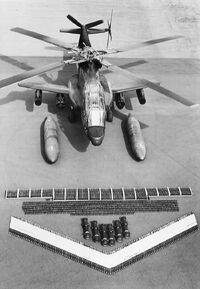
Westland Worcester prototype with ordnance displayed.
The Westland Worcester is a British attack helicopter designed by Westland Helicopters.
History[]
During the Middle Eastern War, the Westland Wiltshire had proven to be extremely useful in the transport and gunship role, but several engagements had shown that it was too slow and vulnerable to ground fire to act as a true attack helicopter as envisioned by the Ministry of Defence. Therefore Operational Requirement OR.64.AH1 was issued in 1964, calling for a dedicated attack helicopter. Only two entries were received, one from Bell Heavy Industries in Canada and another from Westland. Bell soon dropped out when it became apparent that the company was too small for a project of this size, while the Westland entry was developed further.
The first two prototypes (W-56A and -56B) first flew in 1966, and quickly showed that the push propeller at the rear and the downward tailfin needlessly complicated the aircraft and prospective maintenance cycles, as well as drastically increasing it's weight. The first two issues were remedied, and while the helicopter never quite reached the projected minimum weight and speed, it was still accepted to supplement the heavy attack/transport Fairey Rotodyne, entering service in 1968.
In 1976, Westland began development of the "Life Extension and Upgrade System" which was to give the Worcester the ability to use new guided weapons then entering service or in late development, but persistent weight issues and increasingly complicated electronics delayed implementation.
The Westland Super Worcester, which entered service in 1979, includes a second engine, a lengthened tail boom, and additional hardpoints.
Super Worcester[]
In 1976, Westland began development ot the "Life Extension and Upgrade System" which was to give the Iroquois the ability to use new guided weapons then entering service or in late development, but persisting weight issues and the increasingly complicated electronic systems delayed things, and when the Super Worcester entered service in 1979, it was twin engined (at the request of the Royal Marines who had expressed interest in 1977) and had a lengthened tailboom and two additional hardpoints on each side. Most other changes were less visible, but put together essentially turned the Super Worcester into an entirely new aircraft
The Super Worcester series can be considered equivalent to the OTL AH-64 and variants.